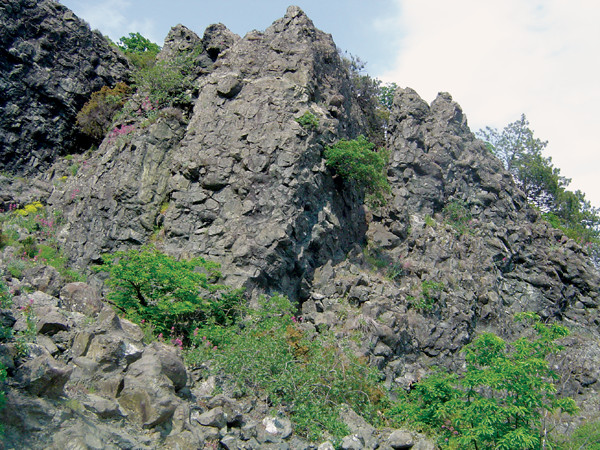
by Timothy Oleson Tuesday, December 9, 2014

Part of an ophiolite sequence in northern Italy. Credit: ©Qfl247, CC BY SA 3.0.
Long recognized as slivers of oceanic crust incongruously emplaced on land, ophiolites are distinctive sequences of basalt, gabbro and peridotite found globally near former and current convergent zones, where oceanic tectonic plates subduct under continents. But scientists don’t have a clear idea why or how ophiolites split from downgoing plates and find their way onto land. Now, a new study suggests part of the answer may relate to weak layers of mantle that allow oceanic crust to be peeled, or “skinned,” from subducting slabs as they descend.
Before diving under overlying continents, downgoing oceanic plates first bow upward slightly in a region known as the outer rise, which lies roughly 50 kilometers seaward from the subduction trench. This flexing fractures the brittle oceanic crust, creating faults that allow seawater to penetrate about 5 to 7 kilometers down into the uppermost part of the mantle. Reaction of seawater with peridotite in the mantle forms serpentine — a soft mineral known to deform easily under pressure — potentially creating a mechanically weak layer separating the crust from the rest of the subducting plate.
It’s unclear how expansive or thick this weak layer could be, or how much serpentine it might contain, but its presence isn’t just theoretical. Seismic reflection studies of oceanic lithosphere in parts of the world such as near Nicaragua show “strong evidence” for a low-seismic-velocity layer beneath the crust, the most plausible explanation of which is “a lot of serpentinization,” says Jason Morgan, a geodynamicist at Royal Holloway University of London who was not involved in the new study.
In this case, “a lot” could be the roughly 10 to 20 percent estimated from the seismic studies, says Katharina Vogt, a geologist at Utrecht University in the Netherlands and lead author of the study, published in Geology. And past lab experiments have suggested that as little as 10 to 15 percent serpentine is enough — like a weak link in a chain — to control how strong peridotite is.
To test whether such a layer of serpentinized mantle could lead to skinning of oceanic crust from downgoing lithosphere, Vogt and her colleague, Taras Gerya of ETH Zürich in Switzerland, created a 2-D computer model of a generic subduction zone. The system’s overall behavior was governed by established estimates of the different rocks’ mechanical properties and a convergence rate of 3.5 centimeters per year. During 20 model runs, they varied the thickness of the serpentinized layer from 3 to 9 kilometers, as well as its composition from zero to 100 percent serpentine (in increments of 25 percent).
After running the model for millions of simulated years, the researchers observed in most runs that large fragments of crust did indeed break off above the weak serpentinized layer as it arched downward below the continent. The slab skinning occurred for all thicknesses of the weak layer tested, as long as the serpentine content was at least 25 percent, Vogt and Gerya reported. After breaking loose, some crustal fragments became lodged deep in the wedge of sediments that accretes in subduction zone trenches, while others were thrust upward and emplaced as ophiolites on the continent. In some cases, the fragments stacked up like pancakes in the accretionary wedges as they periodically broke from the subducting slab.
Researchers once thought it was “mechanically too difficult to detach oceanic crust from the downgoing slab” in this way, but the new results suggest it is feasible, Vogt says. Moreover, she says, the behavior seen in the models appears consistent with geophysical observations from some modern-day subduction zones, such as the Sunda Arc. This is one area “where this [skinning] may occur in the future, where the oceanic crust may actually break and detach from the downgoing slab,” she says.
The study is a “big step” toward demonstrating that a thin layer of serpentinized mantle could catalyze the birth of ophiolites, Morgan says, although he says it offers “a beginning point and not an ultimate answer.” There’s still a lot to learn about the rheology of subduction zones, he notes.
Additionally, the “big question,” he says, is why, if it happens in some places, it does not happen in others. Off the coast of Nicaragua, for example, “we see a lot of serpentinization happening, but we do not see evidence of this stripping process.” The convergence rate could be one factor, he says. Whereas the model considered a typical convergence rate of 3.5 centimeters per year, the Cocos Plate off Nicaragua is subducting very rapidly — about 9 centimeters per year. “Maybe when [plates] are going down a lot faster, it doesn’t happen.” Regardless, the whole process “needs more exploring.”
© 2008-2021. All rights reserved. Any copying, redistribution or retransmission of any of the contents of this service without the expressed written permission of the American Geosciences Institute is expressly prohibited. Click here for all copyright requests.